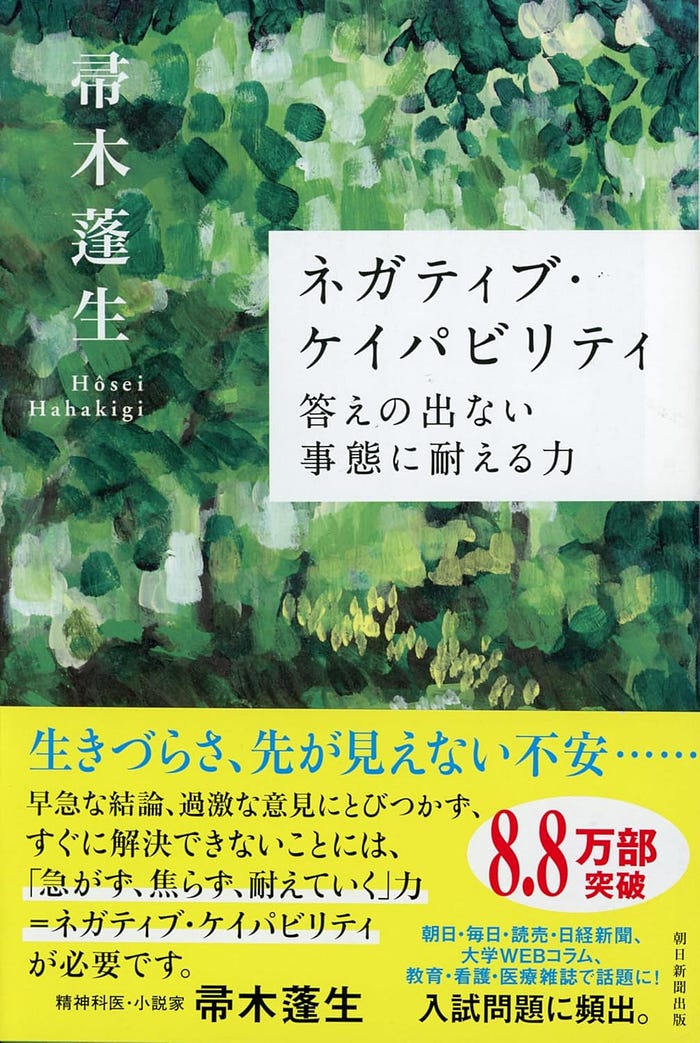Most of us are taught to value quick answers and solutions, whether in school, work, or daily life. But in ネガティブ・ケイパビリティ―答えの出ない事態に耐える力 (Negative Capability: The Power of Embracing Uncertainty), psychiatrist Hosei Hahakigi challenges this conventional thinking.
The book argues that true ability isn’t always about solving problems swiftly — it’s about learning to endure uncertainty and live with questions that don’t have easy answers.
In this review, we’ll explore the thought-provoking questions Hahakigi raises: Why do we feel so uncomfortable with unresolved issues? How does our education system, which often prioritizes answers and outcomes, shape our responses to ambiguity?
And what does it mean to become wiser in a world where simple solutions are increasingly rare?

The Book in 3 Sentences
- The book explores the concept of “Negative Capability,” the ability to endure uncertainty and ambiguity without rushing to conclusions — an idea originating from poet John Keats and expanded by psychiatrist Wilfred Bion.
- Through the lens of psychiatry, education, and creative practice, the author emphasizes that empathy, when matured, forms the foundation for developing this essential capability.
- The book advocates for embracing unresolved situations with patience and compassion, offering a deep, humanistic alternative to today’s overemphasis on immediate answers and positivity.
Impressions
How Did I Discover It?
I found this book on my mom’s shelf — and I’m glad I did.
Who Should Read It?
I would recommend this book to:
- Mental Health Professionals and Therapists: The book offers valuable insights into empathy and dealing with uncertainty, which are essential in therapeutic work.
- Educators and Medical Professionals: These individuals often face complex, ambiguous situations where clear-cut answers aren’t always available, making the book’s teachings on tolerance for uncertainty highly relevant.
- Creative Individuals (Writers, Artists, Musicians): Those in creative fields can learn how to embrace ambiguity and uncertainty, which can fuel their work and artistic expression.
How the Book Changed Me
1. The Value of Facing Unanswerable Questions
This book helped me recognize the quiet richness in being able to confront and dwell in questions that have no immediate answers. In today’s world, with its constant demand for speed and efficiency, we are increasingly losing opportunities to engage with the kind of uncertainty that deepens our humanity. I realized anew that unless I intentionally seek out these moments of ambiguity, I may miss the chance to grow in meaningful ways. The book reminded me that brushing up against the unknown is not just a discomfort — but a privilege.
2. How to Be Present with Someone in Pain
I also learned how important it is simply to be with someone who is suffering, even if we can’t offer solutions. Being physically and emotionally present can carry great meaning for the person in pain. No one can suffer alone indefinitely. When someone feels that their pain is seen or shared — even silently — they often find surprising strength to endure it. This insight gave me comfort: I don’t have to have all the answers or “fix” the situation. My presence itself can be enough. That shift helped ease the fear of feeling useless in the face of another’s distress.
3. Hope as a Form of Negative Capability
I came to understand that my own tendency to believe “somehow, the future will be okay” — even without clear evidence — isn’t just naïve optimism. Rather, it may be a form of Negative Capability: the inner strength to remain in unresolved, painful, or complex situations without forcing closure. The book helped me reframe this trait in myself. Enduring ambiguity with hope, without rushing to conclusions, can be a profound strength in uncertain times.
My Top 3 Quotes
- “The human brain, like a drowning person grasping at straws, tries to find meaning even in things it doesn’t understand — and it tends to lean toward hopeful interpretations. Precisely because we have this tendency, things often work themselves out somehow, and there’s no need to rush into drawing black-or-white conclusions. If we can endure the twilight of the gray zone a little longer, we may notice that the sky in the east is beginning to lighten.”(ヒトの脳は、ちょうど溺れる人が藁をも掴むように、わけの分からないものに 意味を見出そうとし、それは希望的な方向に傾きがちです。この傾向があるからこそ、物事は何とかしているうちに何とかなり、早々と白か黒かの結論を出 す必要がないのです。薄暮のようなグレーゾーンを持ちこたえているうちに、東の空が明るくなる のに気がつくのです。)
- “The more you learn, the more an unknown world unfolds before you. The more you study, the more you realize that the path stretches on endlessly. Even when you climb a slope thinking you’ve reached the pass, you see yet another, even higher mountain beyond it. You could stop climbing there — but once you’ve seen that peak, you can’t help but want to reach it. That is the nature of the human heart, and the power of learning. In other words, the very essence of education lies in the challenge of continuing to seek answers to questions that may never be fully resolved.”(学べば学ぶほど、未知の世界が広がっていく。学習すればするほど、その道がどこまでも続いて いるのが分かる。あれが峠だと思って坂を登りつめても、またその後ろに、もうひとつ高い山が見 える。そこで登るのをやめてもいいのですが、見たからにはあの峰に辿りついてみたい。それが人 の心の常であり、学びの力でしょう。つまり、答えの出ない問題を探し続ける挑戦こそが教育の真髄でしょう。)
- “Those who learn quickly also tend to give up quickly. It was the ones who were slower to learn who continued down the path without giving up. In fact, negative capability is more likely to be found in those who are less naturally gifted — that is the real proof.”(覚えが早いと見切りをつけるのも早く、じっくりその道を諦めずに歩み続けるのは、覚えが悪い 人たちだったのです。ネガティブ・ケイパビリティは、むしろ鈍才のほうが持っている証拠でしょう。)
In a world that often celebrates quick fixes and immediate results, Negative Capability reminds us of the quiet strength found in patience and uncertainty.
It invites us to embrace the unanswerable, to live in the gray zones, and to trust that clarity can emerge in its own time.
Perhaps, as Hahakigi suggests, the true measure of our capability isn’t how swiftly we solve problems, but how gracefully we endure the unresolved moments.
After all, it’s in these moments that we might just discover the answers we never thought to seek.